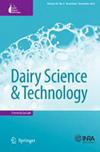Packaging Weight, Filling Ratio and Filling Efficiency of Yogurt and Relevant Packagings Depending on Commercial Packaging Design, Material, Packaging Type and Filling Quantity
Q2 Agricultural and Biological Sciences
引用次数: 2
Abstract
Yogurt is a diverse dairy product category. It is available in different packaging designs made of different materials. To identify potential for improvement for these packagings, a better understanding about used materials and packaging efficiencies is necessary. For this study, 150 dairy products and some yogurt relevant desserts were bought from various supermarkets, street markets and discounters in the Munich region (Germany) in spring 2022. Commercial types of packaging are cups, buckets, pouches, bottles, glass packagings and bricks. The filling ratio of most packagings is above 70%, the rest of the volume is headspace. Poly(1-methylethylene) (PP) and poly(1-phenylethene) (PS) dominate as main materials for the different types of packaging. For bottle packagings, poly(ethylene terephthalate) (PET) and polyethene high-density (PE-HD) are used. Interestingly, poly(lactic acid) (PLA) is not found. Closures (caps) are responsible for 5 to 30% of the total packaging weight. Typical filling efficiencies are 20 to 40 g food product packaged in one gram of packaging material. For glass packagings, the values are 1.5 to 2 g food product packaged in one gram of packaging material. Therefore, plastic packaging results in an at least ten-times lower packaging use per unit of food, at single use packagings. With increasing product weights, we observe a tendency towards higher packaging efficiencies. By using paper/carton wrapping at cups, plastic use is reduced for the whole packaging.根据商业包装设计、材料、包装类型和填充量,酸奶及相关包装的包装重量、填充率和填充效率
酸奶是一种多样化的乳制品。它有不同的包装设计,由不同的材料制成。为了确定这些包装的改进潜力,有必要更好地了解使用过的材料和包装效率。在这项研究中,研究人员于2022年春季从慕尼黑地区的各个超市、街头市场和折扣店购买了150种乳制品和一些与酸奶相关的甜点。商业包装类型是杯,桶,袋,瓶,玻璃包装和砖。大多数包装的填充率在70%以上,其余的体积为顶空。聚(1-甲基乙烯)(PP)和聚(1-苯乙烯)(PS)作为不同类型包装的主要材料占主导地位。对于瓶子包装,使用聚对苯二甲酸乙二醇酯(PET)和聚乙烯高密度(PE-HD)。有趣的是,没有发现聚乳酸(PLA)。瓶盖占包装总重量的5 - 30%。典型的灌装效率是20至40克食品包装在一克包装材料。对于玻璃包装,该数值为每克包装材料包装1.5至2克食品。因此,在一次性包装中,塑料包装导致每单位食品的包装使用量至少降低十倍。随着产品重量的增加,我们观察到更高包装效率的趋势。通过在杯子上使用纸/纸箱包装,减少了整个包装的塑料使用。
本文章由计算机程序翻译,如有差异,请以英文原文为准。
求助全文
约1分钟内获得全文
求助全文
来源期刊

Dairy Science & Technology
农林科学-食品科技
CiteScore
2.30
自引率
0.00%
发文量
0
审稿时长
2 months
期刊介绍:
Information not localized
 求助内容:
求助内容: 应助结果提醒方式:
应助结果提醒方式:


